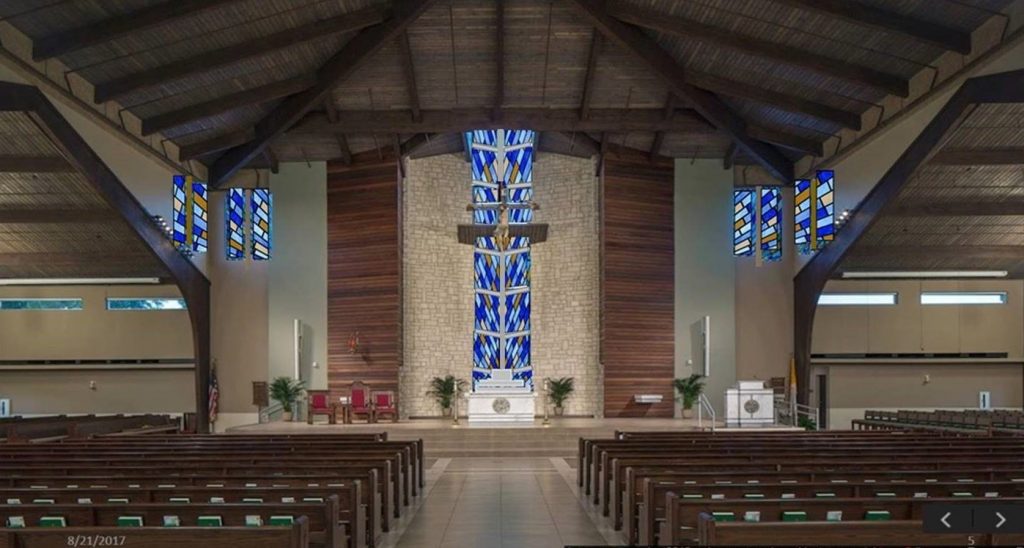A Message From the Clergy

“I saw something like the appearance of fire and brilliant light surrounding him. The appearance of the radiant light resembled that of a rainbow shining in a cloud on a rainy day. This was what the appearance of the form of the glory of the Lord resembled. When I saw all of this, I fell flat on my face. Then I heard a voice speaking. . . . You must speak my words to them.”
–(Ezekiel 1:27b-28, 2:7)
I believe these words of the Prophet Ezekiel, describing the vision he experienced and the call he received, reflect the design of the stained-glass windows in the sanctuary. For us, the source of this radiant light is the presence of the Blessed Sacrament in the Tabernacle. As we pray in silent adoration before the Blessed Sacrament, may we experience, like Ezekiel, the radiating love and grace of God, and hear His call to us to go forth and proclaim His word.
Also, in the celebration of the Eucharist, as we gather around the Altar of Sacrifice, offering to our Heavenly Father, in union with Jesus through the power of the Holy Spirit, the one perfect sacrifice of praise, the stained-glass windows serve as a visible reminder of the invisible reality of God’s unconditional love radiating into our lives and the life of the Church through Jesus, the Bread of Life and the Cup of Salvation. Jesus, our nourishment and strength, who sends us forth to radiate His love and mercy to all people.
Inspiration from the Architects
The celebration of the Eucharist is the center of Christian life, both for the universal Church and the SVDP community. All other sacraments and ministries are linked to the Holy Eucharist. With this understanding, the celebration of the Eucharist is the starting point for the design and placement of spaces, sound, and visibility of the church building. The design attempts to bridge the worlds of the visible with the invisible.
The plan of the church is in the traditional cruciform. The symmetry reinforces the historical church and the simplicity of the parishes Patron. The overall volume and form of the church is designed to celebrate and announce the Eucharist to the community within and the community at large. Starting with the Narthex the volumes telescope as they reach the sanctuary and the Altar, the center of thanksgiving. The sanctuary volume opens as a seven-foot vertical opening that ascends to God as the Holy Spirit descends on the community. The vertical open serves as a sanctuary lamp to the community at large. The Tabernacle is at the base of the slit and is accessible to the church and chapel. The axial relation and alignment of the narthex, baptistery, nave, sanctuary, altar, crucifix, tabernacle, and chapel is purposeful to focus on the Eucharist.
The volume of the chapel also ascends upward to the vertical opening calling attention to the Eucharist. The narthex volume rises in the center third of the space to help call the community to the Eucharist and serve as the threshold from outside environment to the celebration. The bridal room and vesting sacristy are in adjacent proximity. The baptistry is in the narthex and a canopy over the font compresses those who pass under and serves to recall our baptism before we enter the nave. The compression opens to the grandeur volume of the nave and helps accentuate the majestic experience. The reconciliation rooms are visible and accessible on each side of the nave and are adjacent to the Stations of the Cross to remind us that Jesus died for our sins and of His forgiveness. The Stations are located as seven panels between the windows along the aisle ambulatories on each side of the main nave.
Carrying over the traditions of the parish from its beginning as a mission parish to what it is today embraced some physical and spiritual aspects. The Georgia Blue stone, natural wood glue-laminated structure and prairie style were considered and transitioned into the design. They were used to complement the existing structure while transitioning into a new form and materials that are unique to the larger scale. This transition remembers the past and forges a new path. The spiritual transition of the parish’s deep devotion to the Eucharist was transitioned into all aspects of the building orientation and form. The forms help to announce and celebrate the Eucharist and state the faith of the community. There should be no question that the Eucharist is the heart of St. Vincent de Paul and the universal Catholic community.

